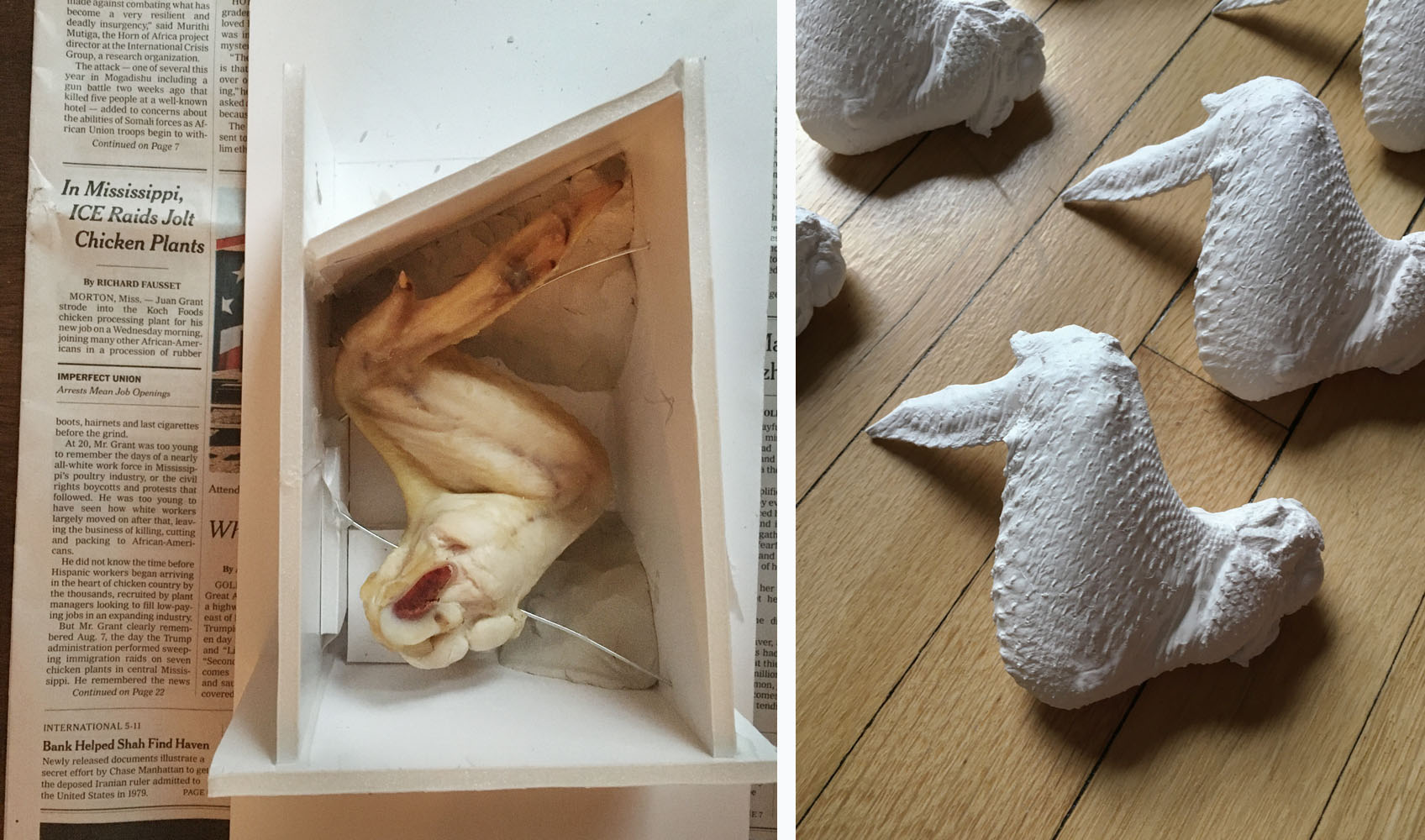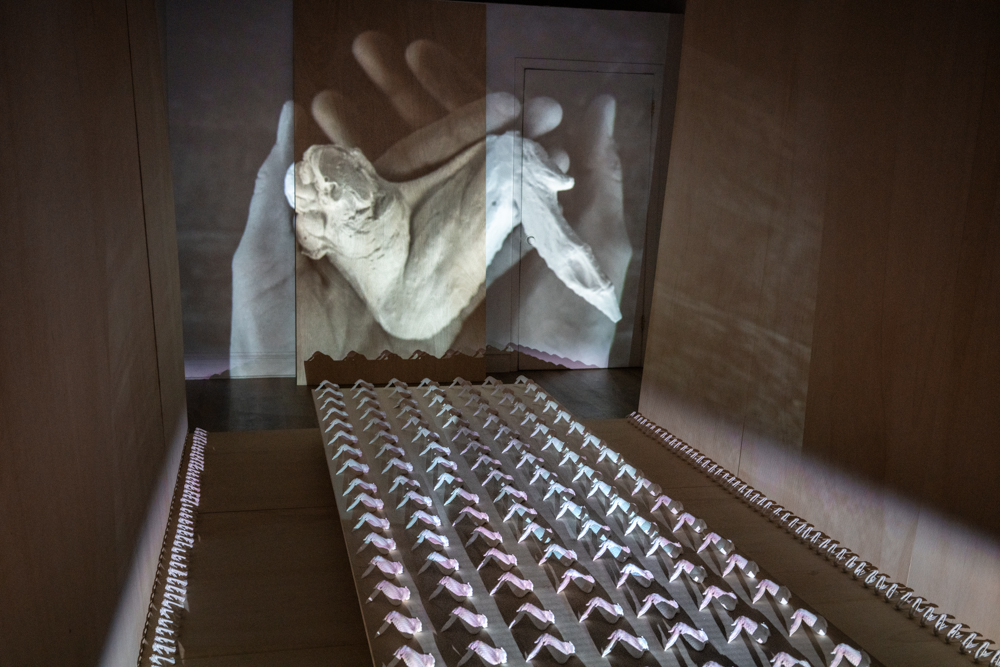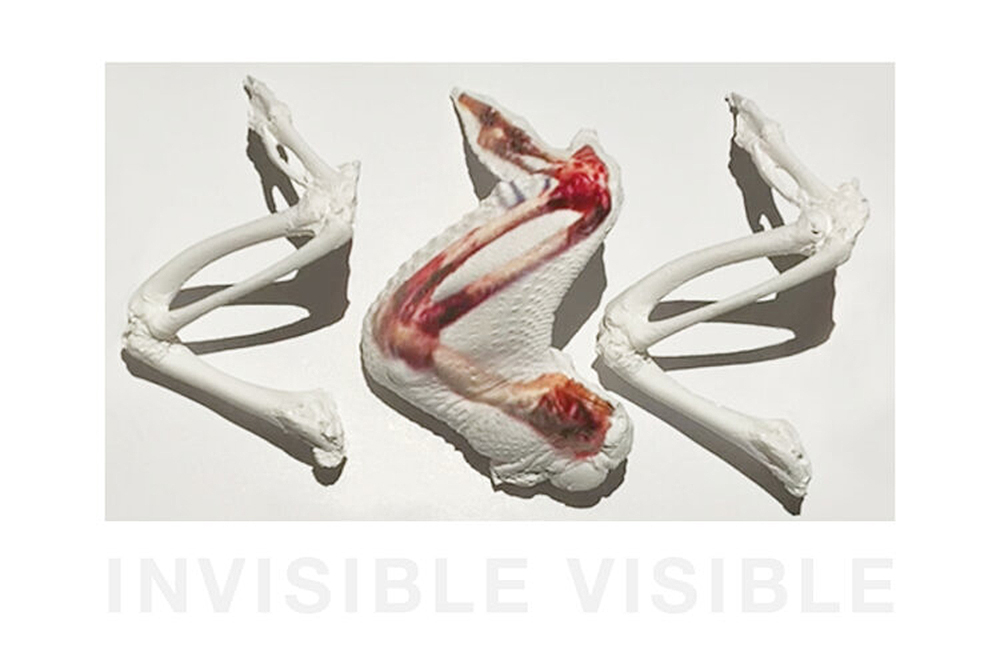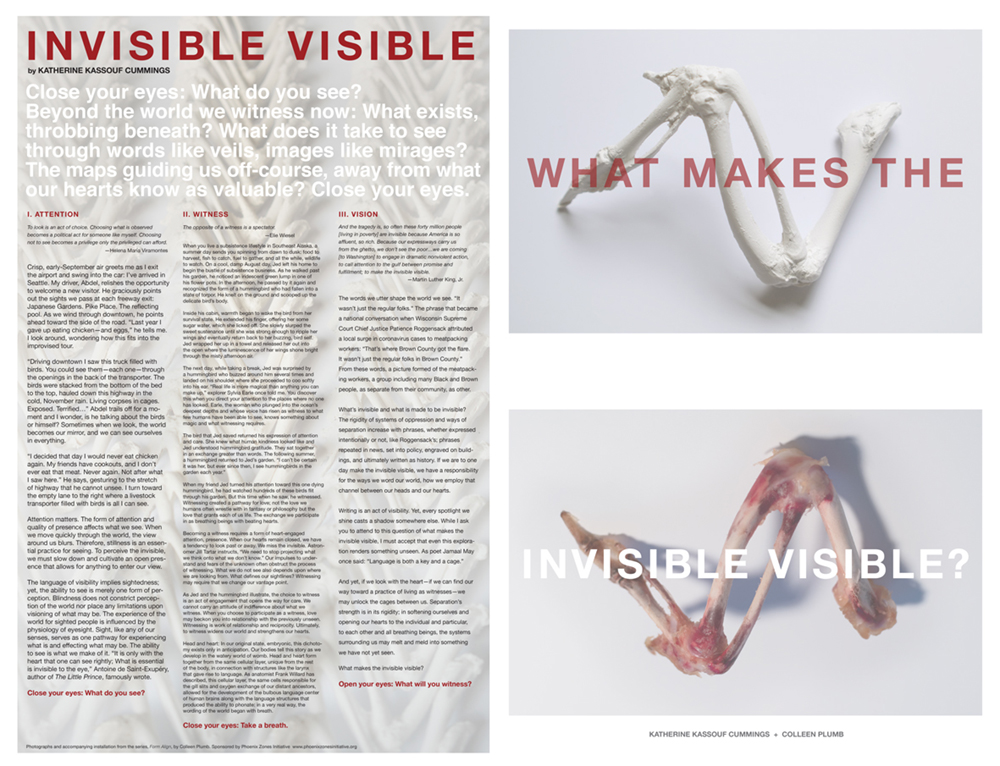Politics in the Kitchen: Colleen Plumb
Through photography, sculpture, video, and writing, Invisible Visible was created through a conversation between artist/photographer Colleen Plumb and writer Katherine Kassouf Cummings. It is an examination of our relationship with invisible costs of consumption that exist below the surface.
We have known Plumb for a number of years, inspired and enlightened by her passion and for all living creatures. She tirelessly pursues her animal subjects, digging deep to uncover nuances of both their behavior and ours that adds clarity to the consideration that all creatures are connected. Colleen’s latest collaborative piece with writer Katherine Kassouf Cummings is both timely and revelatory.
Although this work was done before the pandemic, poultry processing plants and the substantial immigrant work force are rarely considered as we sit down to a bucket of KFC or order some McNuggets. As the Covid pandemic revealed early on, processing plants were super spreaders. Labor conditions, dangerous and poorly monitored by OSHA, fostered uncontrollable contamination. Invisible/Visible traces the politics of the kitchen back to the factory and forward to our habits of consumption. In addition to considering the brutality of the poultry industry, this video installation with text and sound components, forces us to consider the invisible labor force behind cheap food.
Installation: A black and white rear screen video projection shows gentle handling of plaster-cast chicken wings. Wing after wing being passed in endless succession. From the front, another projection slowly appears and disappears revealing color photographs of wing bones. The red, flayed bones “breathe” onto the installation’s grid of row after row of plaster-cast sculptures of the wings. The projected image moves our eyes beneath the surface of the wings, into the interior.
As the video loops, we are invited to participate in the act of witnessing animals and the workers together, both subjected to the suffering created by our industrial food system.
In the gallery space, plywood walls surround the wings and bones. A material ubiquitous to this industry, the plywood backrop becomes a stark stage set for the imagery. More cast wing bones along the perimeter mirror the physical experience of workers and animals in a slaughterhouse. Standing in compact rows to reference a relentless conveyor belt ejecting 175 chickens per minute for slaughter.
For Colleen, the ritual creation of each of these fragile, plaster cast wings a gesture and acknowledgment of the suffering of fellow living beings.
Outside the installation, the artists hung a newsprint poster bound into a pad, for a take-away. The text addresses the question of what makes the invisible visible. Writer Katherine Kassouf Cummings describes a practice of attention, witness, and vision for relating with, and welcoming into view, the invisible. The reader traverses through stories that lead to the interior, beyond the visible and back through imagining. Viewers may listen to Cummings words via an online recording.
LISTEN TO THE RECORDING: written and read by Katherine Kassouf Cummings
All those experiencing this work are invited to absorb the images and writings—to take the stories with them—and carry their questions out into the world.
How did you come to this project?
Colleen: In late 2019, I read an article by Human Rights Watch titled, Blood, Sweat and Fear: Workers’ Rights in U.S. Meat and Poultry Plants that so disturbed me, it set in motion a quest to create a project that could attempt to address or try to manifest an act of witnessing the many lives involved in factory farming: the chickens and the workers, together subjected to the suffering created by our industrial food system. I taught myself how to make molds and began casting chicken breast, then chicken feet, and finally landing upon casting a series of wings and the delicate bones concealed inside.
My original idea was to make a giant pile of 175 chicken breasts, to see what such an abstract number looked like physically. 175 is the ‘line rate’ of birds killed every 60 seconds in factory slaughter in the United States.
I went to a poultry market and asked if I could buy a chicken’s foot. Instead they gave me a bag full of feet. Walking out, clutching the plastic bag, heavy and rounded out at the bottom, I was in disbelief of the sensory gore I just experienced. Even before becoming vegan, I admit I did not think too deeply about how the chickens I consumed were killed. Or their lives, for that matter. Or the lives of those who killed them for their job.

Process: chicken wing mold, Invisible/Visible © 2020 Colleen Plumb/ Process: cast wing, Invisible/Visible © 2020 Colleen Plumb
Casting wings, with their textured skin and bent-arm shape, seemed like a direct, immediate way to connect to the bird’s actual life. I spent the entirety of 2020 casting the wings and bones. Each wing was made as a ritual for an individual life. Each bone cast signaled a seeing of the invisible factory worker: unprotected, in an exploitative system that exemplifies corporate greed, and hides in plain sight. Cheap meat, (all meat), has a deep, invisible cost.
In January 2021, upon completion of 350 wing and bone sculptures, I created a site-specific installation at the Riverside Art Center, including the video that swept along the back walls of the space.
Project sponsored by Phoenix Zones Initiative, a nonprofit organization on a mission to advance rights, health, and wellbeing. Led by physicians and a diverse cross-sectoral team, Phoenix Zones Initiative recognizes the inextricable links between the welfare of people, animals, and our life-sustaining planet in the struggle for social and environmental justice. We focus on robust structural change by advancing ethical norms, values, legal and economic frameworks, and public policy to improve the lives of the most vulnerable and marginalized people and animals. Our programs center on critical needs and acute intersections between human, animal, and planetary wellbeing.
BIO
Colleen Plumb makes photographs, videos, and installations that look at the complex and contradictory relationships humans have with nonhuman animals. Plumb’s work is held in several permanent collections and has been widely published and exhibited. Her 2021 installation, Surveilling Snow Lily, at Roman Susan in Chicago, was highlighted as a must-see in ARTFORUM gallery guide. Plumb’s first photography monograph, Animals Are Outside Today, Radius Books, 2011, critically documents humans’ ambivalent dispositions towards animals. Plumb’s recent photography book, Thirty Times a Minute, Radius Books, 2020, examines the plight of captive elephants. It was listed as a LensCulture favorite book of 2020, by Eastman Museum curator Lisa Hostetler. Plumb lives in Chicago and has taught photography and video at Columbia College Chicago since 1999. IG @colleenplumb
Katherine Kassouf Cummings is a daughter, a sister, a friend, a teacher, an ecological citizen, and a writer. She co-edited the book What Kind of Ancestor Do You Want to Be? (University of Chicago Press, 2021). She serves as Managing Editor at the Center for Humans and Nature. When not at her desk, Katherine shares her passion for movement and women’s health as a Pilates instructor.
Barbara Ciurej and Lindsay Lochman are photographic collaborators. As an extension of their long-term examination of the domestic realm, their current work addresses climate change, consumption and connection through food.
Website: www.ciurejlochmanphoto.com
Instagram: @barbandlindsaycollaborate
Posts on Lenscratch may not be reproduced without the permission of the Lenscratch staff and the photographer.
Recommended
-
Salua Ares: Absense as FormNovember 29th, 2025
-
Ricardo Miguel Hernández: When the memory turns to dust and Beyond PainNovember 28th, 2025
-
Pamela Landau Connolly: Columbus DriveNovember 26th, 2025
-
KELIY ANDERSON-STALEY: Wilderness No longer at the Edge of ThingsNovember 19th, 2025
-
Jackie Mulder: Thought TrailsNovember 18th, 2025




























































